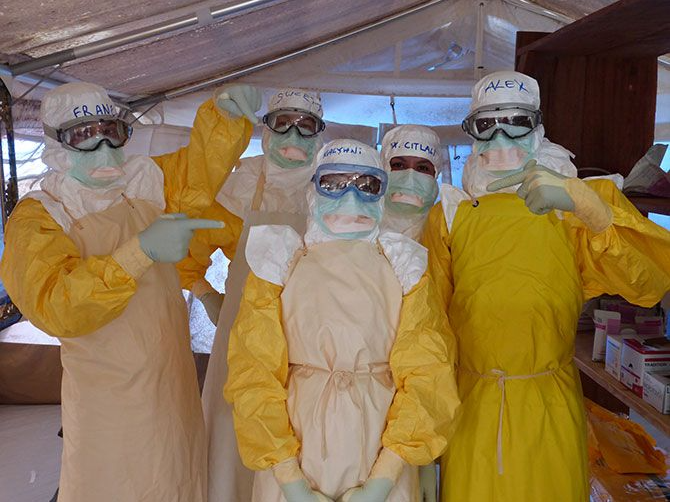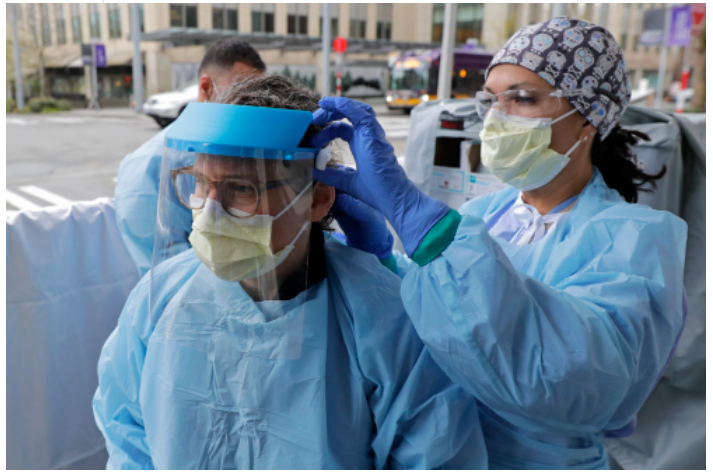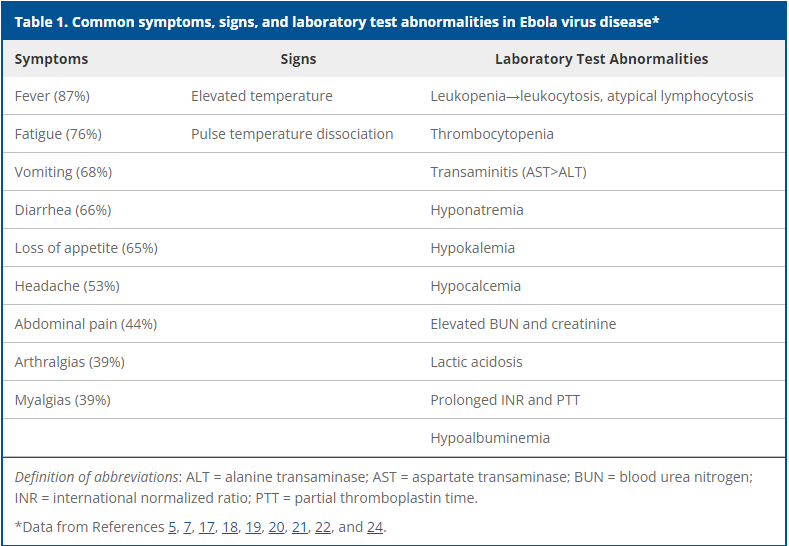

Pictured: COVID-19 Pandemic doctors.
Psychologist have often suggested the study of human nature corresponds significantly with the study of history. A prime example of this is the examination of pandemics, past and present, and a comparison to how human populations respond to them in different times. Modern pandemics such as Covid-19 and Ebola can be cross-analyzed, looking for patterns in human choices, mindsets, and repercussions. Historic pandemics are also a key point in these studies. The examination of pandemics such as Cholera and AIDS are other key pieces in understanding how humans, historically, respond to pandemics. Pandemics and disease obviously bring about outwardly symptoms and presentations, some more serious than others. And its these outwardly symptoms that determine how the public masses respond to the diseases.
This is seen in both Covid-19 and Ebola outbreaks. However, both Covid and Ebola are recent enough pandemics that I personally can recall how society reacted to each respectively. Despite the zero to no threat posed by Ebola in countries such as The United States, there was still significant panic regarding the nature of the disease. Its violent and potentially bloody presentation in patients had been captured by media and was causing quite a domestic stir in places where Ebola never reached ever. On the contrary, Covid-19s presence was global, and the high contagion possibility led to at least 80 million Americans contracting the disease. Covid however was presented less ominous, more flu-like symptoms that led to many downplaying the pandemic. That coupled with the 99% recovery ratings can be speculated to be the cause of many people’s lacks of worry on the matter. These two pandemics led to very different societal reactions, reactions that almost seem nonsensical when approached from a scientific perspective, yet reactions that makes sense when viewed from a historical perspective.
The Ebola pandemic, which was originally discovered from the Ebola River in the Democratic Republic of Congo in 1974, affected “estimates of total potential cases range from thousands into the millions of persons” (CDC 2021). This was the first highly publicized pandemic, as journalist and news teams alike flocked to West Africa to capture this pandemic in history. What was captured wasn’t pretty to say the least. Ebola has potentially violent outwardly symptoms and historically its fatality rate is above 50%.

The symptoms not shown in this table include mental breaks, internal hemorrhage, and seemingly unexplainable external bleeding. “However, hemorrhage has been reported in fewer than 50% of cases previously (9). In the current outbreak, only 19% of patients have symptoms of unexplained bleeding,” (West 2014). “The 2014 Ebola outbreak in West Africa was described by the director general of the World Health Organization (WHO) on October 13, 2014 as “unquestionably the most severe acute public health emergency in modern times”” (West 2014). Many of these cases have been documented and photographed and at the time Ebola was a very hot topic. It goes without saying in the world of media, gore sells.
Some articles focusing on the outbreak looked like this:



The Covid-19 pandemic originated from Wuhan, China. On December 12, 2019, a group of patients from the Hubei Providence reported symptoms along the lines of shortness of breath and fever. The whole world felt this pandemic as global shutdowns rattled the economy and unemployment rates skyrocketed. Outside of the economic problems faced during Covid, it affected the way of life for all of society, including additions of social distancing, face coverings, virtual workplaces/schooling, etc. A core difference between Covid and Ebola is that Covid is an ongoing pandemic. Current estimates from the CDC put the case count for Covid at 510 million with a potential 310 million unconfirmed case and the death toll is reported at 6.22 million globally.
These two pandemics yielded greatly different reactions from the general public, the reactions for both are respectable by science, but especially where Covid is concerned, many feel the public reactions to be unwarranted and too extreme. I personally can recall individuals wearing mask during the Ebola pandemic in upstate NY, and spoiler alert, Ebola was never in upstate NY. Yet down the road, I also personally witnessed individuals with positive Covid test unmasked shopping, partying, learning in school and many more instances. When rationally analyzing these ideas, I couldn’t figure out why some people expressed more concern for a disease they will likely never personally encounter, ever. On the flipside Covid was affecting the same individuals, whether they personally caught the disease or not. A correlation I noticed however; many of these individuals who expressed zero worry over Covid-19 fit into the “safe” criteria of the disease (i.e., young, healthy individuals with no underlying medical conditions that might make them more vulnerable to Covid).
When focusing on these specific groups of people (those who overreacted to Ebola and underestimated Covid), the only conclusion that can be drawn about why they react so differently to these two diseases is expectations This is another difference in the two pandemics, while America only ever experienced 11 cases of Ebola, it experienced over 81.3 million cases of Covid-19. Since Covid can be so unproblematic in many cases, especially if one has no underlying health conditions and is healthy, many people’s idea of this pandemic is it poses little to no threat, and the fear around the pandemic is unwarranted. Many of these cases were asymptomatic carriers, and many who experienced symptoms were underwhelmed by the disease, this can lead to public doubt. However, the threat of Covid was very real, and in America the pandemic took 993,000 lives. Of the 11 recorded cases of Ebola in the United States, only 2 of them resulted in fatality.
A key idea to keep in mind when discussing this; the only manner these people got any information about Ebola, since they never had personal interaction with it, is the media. A Harvard study focusing on this same phenomenon as my writing opens with “We find that exposure to social media is associated with misperceptions regarding basic facts about COVID-19 while the inverse is true for news media. These misperceptions are in turn associated with lower compliance with social distancing measures.” (Harvard 2021). Social media affects people’s outlooks and perspectives towards occurrences in their day-to-day life more so than they believe. Often times information acquired online will be written off as true in one’s mind, this is unproblematic if the information is actually true, but especially on the matter of an ongoing pandemic, not even pandemic experts were 100% certain of many findings. “Spending time in a media environment that contains misinformation is likely to change attitudes and behaviours. Even if users are not nested in networks that propagate misinformation, they are likely to be incidentally exposed to information from a variety of perspectives.” (Harvard 2021). The effect this had on COVID-19 was many underestimating this pandemic, the effect this had on Ebola was many overestimating that pandemic.
It’s almost hard to blame people who were subject to COVID-19 misinformation, considering most of it came from the active President of the United States. A conglomeration of this is pictured below



Experts from the prior mentioned Harvard study believe the active president was the main cause of COVID-19 misinformation. And experiencing the pandemic for myself in my small upstate New York community with registered 89.7% Republican voters was a prime example of what this kind of misinformation can do to society. Individuals in my high school would actively shame those who expressed worry or concern over the ongoing pandemic, often sourcing the 99% recovery rate for their claims or that as teenagers there is nothing for us to fear. Students who were exposed to COVID-19 wouldn’t see the quarantine memo’s they received as just 14 days off from school, but as 14 days to do whatever they pleased, and what they pleased was not quarantine.
Ultimately, as COVID-19 continued to ravage New York and began affecting older and at-risk populations, people’s outlooks began to change. Specifically, in my high school we lost a teacher to COVID-19 and it began to make these individuals realize the severity of this pandemic. Looking back at this whole ordeal I’m able to draw an actual conclusion on the importance of this idea. While COVID-19 wasn’t personally affecting the individuals in my community, their worries were non-existent. Coupled on top of that, when the media they consumed expressed these ideas that this pandemic is being blown out of proportion and the sitting president is telling people to “not be afraid of COVID-19″ it will affect their own perception of the disease. Then when actually faced with real world examples of the severity of this pandemic, their perception changed.
This conclusion can’t yet be drawn for the Ebola pandemic because it never affected these individuals in their own worlds, but in a disease like Ebola with more dangerous and grotesque symptoms, the panic was there from just media consumption alone. I’d like to believe that if this disease affected America, society would be universal in their perceptions of the threat posed by Ebola, and make whatever efforts they as an individual can to combat the pandemic. But hopefully, we’ll never know.
Works Cited.
Eoin, West T, and Amélie von Saint André-von Arnim. “Clinical Presentation and Management of Severe Ebola Virus Disease.” Annals of the American Thoracic Society, https://www.atsjournals.org/doi/full/10.1513/AnnalsATS.201410-481PS.
Leligdowicz, Aleksandra, et al. “Ebola Virus Disease and Critical Illness – Critical Care.” SpringerLink, BioMed Central, 29 July 2016, https://link.springer.com/article/10.1186/s13054-016-1325-2.
“What Is Ebola Virus Disease?” Centers for Disease Control and Prevention, Centers for Disease Control and Prevention, 27 Apr. 2021, https://www.cdc.gov/vhf/ebola/about.html.
“Coronavirus Disease 2019 (Covid-19).” Centers for Disease Control and Prevention, Centers for Disease Control and Prevention, 21 Dec. 2021, https://www.cdc.gov/dotw/covid-19/index.html.
“What Is Ebola Virus Disease?” Centers for Disease Control and Prevention, Centers for Disease Control and Prevention, 27 Apr. 2021, https://www.cdc.gov/vhf/ebola/about.html.
Vitriol, Joseph A., and Jessecae K. Marsh. “A Pandemic of Misbelief: How Beliefs Promote or Undermine Covid-19 Mitigation.” Frontiers, Frontiers, 1 Jan. 1AD, https://www.frontiersin.org/articles/10.3389/fpos.2021.648082/full.
Austin, Emma. “What Is Ebola? Is the United States at Risk of an Outbreak? Here Is What to Know.” Journal, Louisville Courier Journal, 18 Mar. 2021, https://www.courier-journal.com/story/news/2021/03/17/ebola-kentucky-united-states-risk-outbreak-what-you-should-know/4739775001/.
Bridgman, Aengus, et al. “The Causes and Consequences of Covid-19 Misperceptions: Understanding the Role of News and Social Media: HKS Misinformation Review.” Misinformation Review, 26 Jan. 2021, https://misinforeview.hks.harvard.edu/article/the-causes-and-consequences-of-covid-19-misperceptions-understanding-the-role-of-news-and-social-media/.
